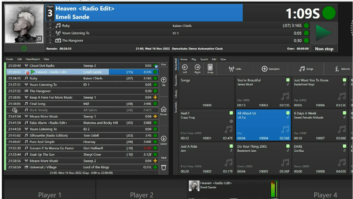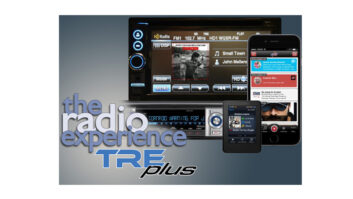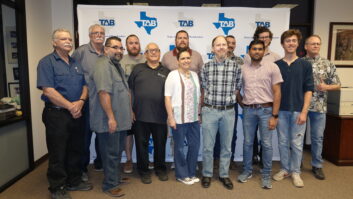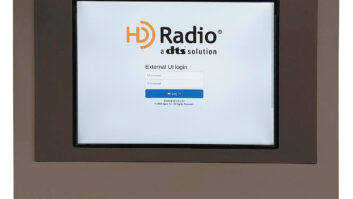Streamlined Station
Apr 1, 2008 12:00 PM, By Dave Lyons
WHKP is a locally owned and operated, stand-alone, heritage, AM station serving Hendersonville, NC, since 1946. WHKP has always been innovative, especially when it comes to marketing the station. In addition to our broadcast services, we also stream our audio content over the Web and on a local cable access channel. We print a local news and advertising magazine, called Peaks, and feature a large, full-color LED sign in front of the station for advertising and station promotion.
When I first assumed the chief engineer duties at WHKP, I inherited a facility that, while beautiful and functional, was aging as far as broadcast equipment. The station had been using the DOS-based RDS/Phantom automation system, since the mid-1990s, for traffic and play-out of commercial material. The station featured mostly live programming from 5 a.m. to 6 p.m. with a satellite-delivered music service at night and on weekends. However, during live programming, the announcers were playing music from PCs, CDs and even records. The control room’s Harris console was at least 20 years old, and the production room had a 10-year-old LPB board � both with no spare parts available.

The turntable”s slide-out drawer is mounted in the equipment rack built into the studio cabinet.
After expressing my concerns to Art Cooley, president and general manager, it was decided that we would undertake a general upgrade of our broadcast facilities, with an eye toward eventually broadcasting in HD Radio. We then toured some area radio stations that had recently upgraded their facilities with new equipment and automation systems. After careful study we eventually decided on Google’s Maestro system for our automation and Radio Systems for our consoles. The Maestro system consists of two audio servers, one assigned to control, the other to production. Since our old automation system also served as a traffic system, we replaced it with Natural Soft’s Natural Log 8 and also purchased their music scheduling program, Natural Music 5.
In addition to the control and production rooms, we had a conference/studio room with a table and microphones (used primarily for group interviews) and a desk with a small mixer and equipment (capable of limited production, mostly for news gathering). We decided to upgrade this room as well, giving it full production capability. Our audio editing software was upgraded to Adobe Audition.

Production room
The control room features a 12-channel, Radio Systems Millenium Digital console, while the conference and production rooms would each have the six-channel versions. The existing patch panels were replaced with Radio Systems Studio Hub+. The control telephone system was upgraded with a new Telos 1�6 digital hybrid system.
We also opted for new furniture in the control and conference rooms. We wanted a stylish, modern-looking effect, that wouldn’t break the bank. We were fortunate to find a local cabinet maker who took our ideas and came up with a very sturdy, nice-looking, functional design. The two rooms feature identical furniture.

Control room with lobby visible through window
Again, with a plan to eventually implement HD Radio, we replaced our 20-year-old Harris SX-1A transmitter with a new, digital-ready Harris DAX-1R. The SX-1A was moved to standby duty.
Getting started
The greatest challenge we faced was completely gutting our existing studios while keeping the station on the air. Our plan was to rebuild the studio/conference room first (giving us some production capability), then rebuild the production room, and finally, move control to the newly rebuilt production room, while the control room was being rebuilt. The control room was completely stripped of every piece of equipment, cabinet, shelf and carpet. Two existing equipment racks were also moved out of the room to a glass-doored closet in the control room, creating less clutter and more room, while still giving the announcers a view to the metering.

Control room with conference room visible through window
Another issue was that our existing LAN was built with CAT-3 wiring and was not capable of handling the traffic of our new Maestro system. Instead of completely rewiring our network, we ran a new CAT-5 network strictly dedicated to the automation system. This would be a closed network with no Internet access to assure no chance of virus infections or hackers.
All existing wiring between all three studios was pulled out and replaced with 25-pair CAT-5 cabling, utilizing punch-down blocks. In addition to the three studios, a central engineering station, consisting of two racks, is tied to all three rooms. The two racks contain the Maestro servers and associated equipment, as well as the five satellite receivers we use for programming content. With this configuration, we are able to patch any audio feed, to any room, using either our Broadcast Tools audio switchers or RJ-45 patch panels in the central engineering racks. This gives us the ability to put any of our three studios on the air with some simple patching and/or routing.

Equipment racks in central engineering, containing Maestro Automation on the left and satellite equipment on the right.
Our GM wanted a clean, uncluttered work area, with as little surface-mounted equipment as possible. So we put all rack-mountable equipment in racks that were built into the studio furniture cabinets. This included a turntable encased in a slideout drawer and mounted in the cabinet equipment rack. The cabinets in the control and conference rooms are open on one end to allow easier access for wiring and repairs. And the desk areas of the furniture are completely open underneath, giving easy access to wiring. In the rooms with new furniture you will only see the console, telephone, mic and monitor stands, and keyboards on the desktops. The control and production rooms were also fitted with Auralex foam panels for sound dampening.
We started the project in June 2007 and went on the air from our new control room on Nov. 21, 2007. While the studio work is mostly complete, we are still working on our new transmission equipment. The new DAX-1R transmitter is operating, but we are still installing additional equipment that will be needed when we decide to make our HD Radio transition, including a Belar AMMA-2 Wizard modulation monitor/analyzer.
While WHKP has embraced the future of broadcasting, we haven’t forgotten our past. In our station lobby, we have quite an impressive collection of antique radios, broadcast equipment, records, pictures and news articles, mostly donated by area residents. Now in our 62nd year of broadcasting, we’re an AM radio station looking forward to tomorrow.
Lyons is chief engineer of WHKP-AM, Hendersonville, NC.
Equipment List
Adobe Audition
Aircorp Pro Announcer
Arcview dual monitor arms
Armstrong Xlink
Audioscience 1024
Auralex acoustic foam
Belar AMMA-2
Belkin 8-Port Gigabit Switch
Belkin Wireless G Router
Broadcast Tools SS 16.4, ACS 8.2 Plus
Cyber Power UR500 UPS
DBX 166A, DBX 286A
Dell PCs EVO LCD Monitor Arms
Google Maestro
Harris DAX-1R
JK Audio That-2
Middle Atlantic racks
Natural Soft Natural Log 8, Natural Music 5
Ortronics RJ-45 Patch Panels
Radio Systems Millenium, Studio Hub+
RDL RUDA4D
Sennheiser MD421U
Siemon SIE-S66M150
Telos 1�6
Yellowtec Mika

The production room equipment rack containing the DBX mic and audio processors, Studio Hub panels, Symetrix monitor amp and console power supply.

Production room, right side view












